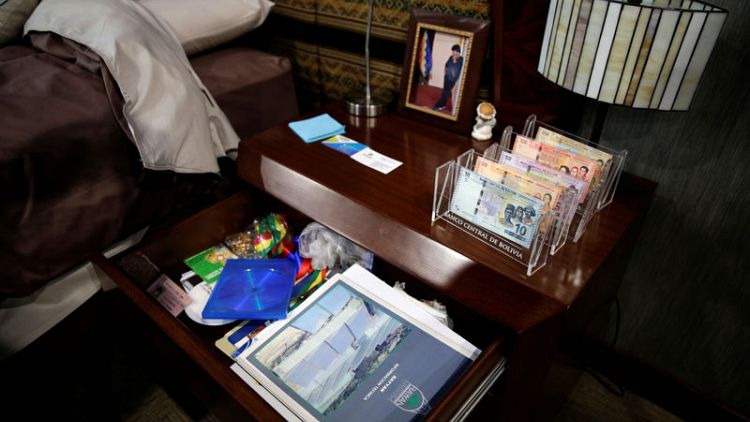By Santiago Limachi and David Mercado
LA PAZ (Reuters) - Embroidered Andean textiles, a selection of bank notes, business papers and a wood-framed photograph on a polished bedside table give a still-life portrait of the presidential home of unseated Bolivian leader Evo Morales.
Bolivia's new interim government opened the doors on Thursday to the former quarters of Morales in the $34 million skyscraper "Big House of the People," which he ordered built towards the end of his nearly 14 years in power.
Morales announced his resignation on Sunday after growing evidence indicated that an October election won by the leftist leader had been rigged in his favour. The once much-vaunted indigenous leader is now in Mexico, where he has been granted asylum.
His departure left a major political vacuum and sparked protests and marches by his followers, especially his large support base within the country's indigenous groups, to whom he helped give a powerful voice.
A former coca-leaf farmer and Bolivia's first indigenous president, Morales was an iconic figure of Latin America's left. He gained admiration for guiding the poor landlocked South American nation through steady growth and stability.
But over time he alienated those who once backed him, especially by building the ostentatious presidential palace and his defiance of term limits to stay in power.
The country's interim leader, Jeanine Anez, is grappling to shore up power even as Morales continues to strike a defiant note from Mexico, where he has insisted he was toppled in a "coup."
The country's new communications minister, Roxana Lizarraga, gave journalists a hour-long tour of the previously off-limits 24th floor of the palace building, where Morales kept a kitchen, a work-out area, bedroom and a large bathroom.
The scene was reminiscent of the triumphant public openings of the palaces of fallen dictators such as Saddam Hussein and Omar Qadaffi. Morales' quarters, though, were far less opulent.
Lizarraga said the palace in central La Paz had been stripped of valuables, leaving it nearly empty. But Morales' bedroom was neatly made, with a photo of him standing relaxed next to a Whipala flag, a symbol of Andean native groups.
In a turquoise tiled bathroom, an upturned hairbrush, razors, deodorant and toothbrush gave a fleeting glimpse into a man who swept to power in 2006 as a great champion of Bolivia's marginalised groups but ended up chased out of power.
Morales oversaw one of the most stable periods in landlocked Bolivia's history. But for his detractors, the Big House of the People became a symbol of excess and a squandering of sorely needed public funds in one of the region's poorest countries.
(Reporting By Santiago Limachi and David Mercado, Writing By Mitra Taj; Editing by Adam Jourdan and Dan Grebler)
